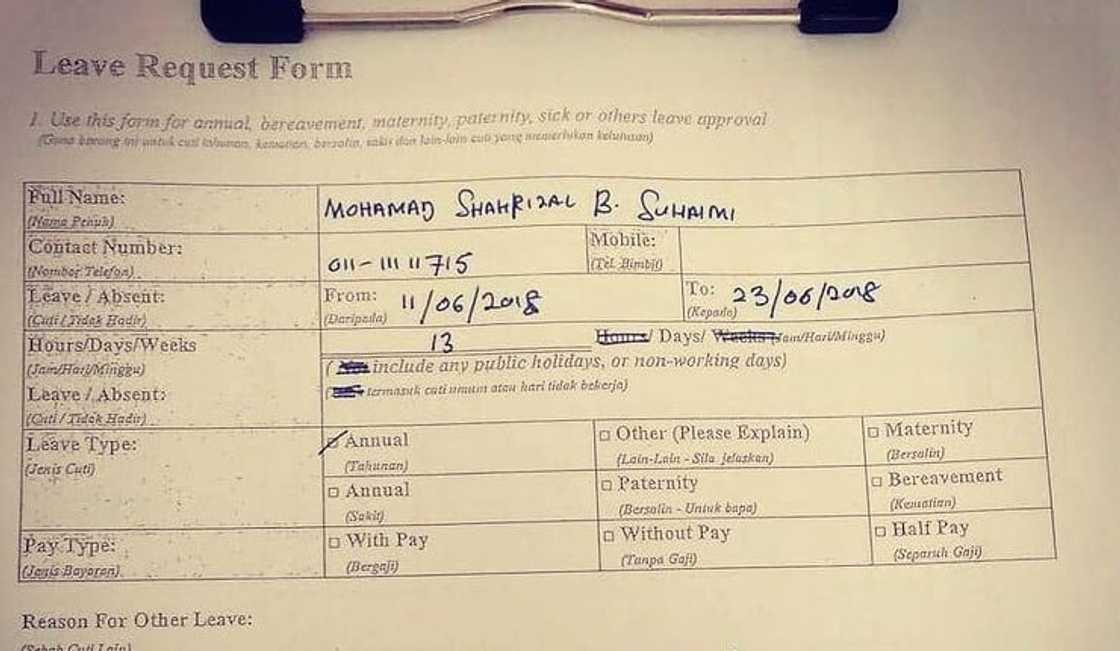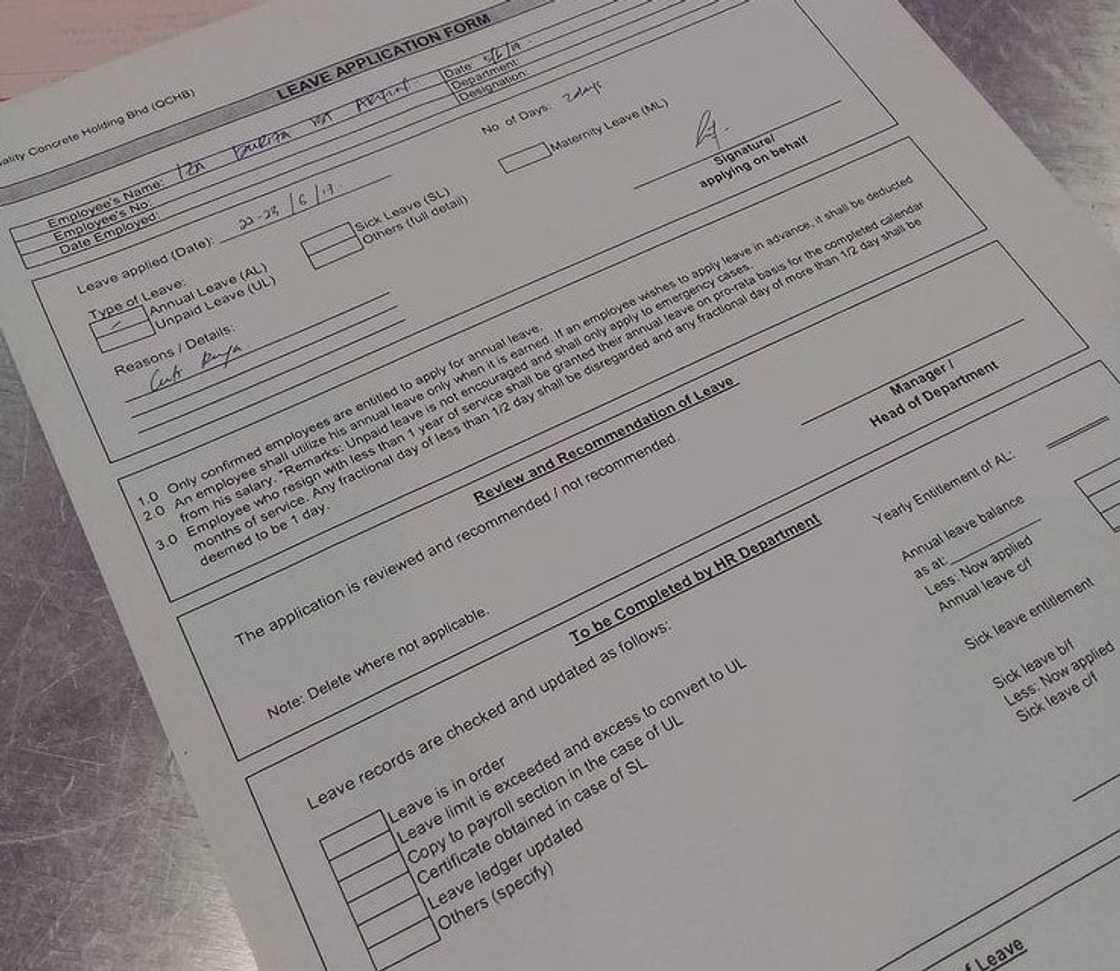Types of leave in South Africa you are entitled to 2022
Are you newly employed in the South African job market and wondering what your formal absence from work options are? What are the types of leave? Navigating the different types of leave in South Africa without sufficient knowledge is quite taxing. However, that will not be the case after you read this.

Source: Instagram
All work without play makes Jack a dull boy, right? Equally, work without taking a break may make any employee unproductive. So, what are the 3 types of leave? Navigating the South African labour law when you can take time from work is not a walk in the park. Here is everything you should know to help you understand your fundamental rights according to the Employment Act Section 19.
Types of leave in South Africa
What are the six different types of leave entitlements? Although organizations differ in operations and terms of employment, employees working for more than 24 hours a month qualify for the following types of leave in South Africa.
1. Annual leave
This is one of the most commonly identified types of leave. So, how many leave days do you get a year in South Africa? According to section 20 (2) part (a), an employee is guaranteed 21 consecutive days on full pay annually.
For employees working on a 5 day week, this translates to 15 working days while those working 6 days weekly get 18 working days of annual leave. It is equally important to note that public holidays falling within the annual legal absence from work duration will not be deducted.
Do your leave days accrue? Yes. Employees may accumulate their permitted off days for the year and redeem them later, depending on their employer's Annual Leave Policy. Employers' annual official absence from work policy may vary from one company to another, and at times the employer is entitled to dictate the timing of accrued off days depending on their busy schedules.

Source: Instagram
2. Maternity leave
According to the Act, maternity off is given to an expectant mother for up to four months and unpaid. The Act additionally stipulates that absence from work, for this reason, should start later than 4 weeks of the expected child’s date of birth and that the employee may return to work after completing 6 weeks after giving birth. However, exemptions to these can only be accepted after the presentation of the employee’s midwife or medical practitioner's written consent.
3. Sick leave
Sick leave is given out to employees to enable them to heal from an ailment. Usually, this is one of the types of paid leave in South Africa, and an employee is guaranteed 15 working days. A sick off cycle is 36 months of employment with the same employer or completing the prior sick leave cycle. For the first 6 months of employment, you are entitled to 1 day of sick absence from work for every 26 days worked.
An employer may require his or her employee to produce proof of illness or incapacity to report, more so in cases where they were absent for consecutive days. Proof of incapacity or illness that is acceptable by the Act is a certificate from a medic or a professional certified by a council to treat and diagnose patients.
4. Family responsibility leave
The family responsibility leave is issued to an employee who has worked for over four months and working 4 days a week for the same employer. According to the law, one is entitled to 3 days of paid family responsibility absence from work per year. However, domestic employees are usually entitled to 5 days family responsibility leave.
While it might seem like the most enticing leave days South Africa, its greatest shortcoming is that it is not accumulative. The leave entitlement ends at the end of the year. Cases that allow you to ask for this type of off from the workplace include when the employee's child is born, sick, or if the employee’s spouse or life partner, biological parent, adoptive parent, grandparent, child, adopted child, grandchild or sibling dies.
5. Study leave
Which are the types of leave for teachers in South Africa? This may be one of the absences from the work period that a teacher may take to advance their studies. Although the South African labour legislation fails to acknowledge this option as leave entitlements in the country, it does exist as an arrangement between employees and their employers. When taking time off work to pursue your education, an employee must decide whether to take their annual leave days per month or take an unpaid absence from work for it to apply.
6. Religious holidays leave
If you are newly employed and are worried about missing your traditional one-week break to pursue religious enrichment, worry not. Like absence from work to pursue your studies, the religious leave South Africa is not regulated by labour law. Currently, should you miss work because of religious holidays besides the official government ones, you will either decide to take an unpaid period off work or have it deducted from your annual off days' entitlement.

Source: Instagram
Apart from the types of employee leave in South Africa discussed above, there may be other leave types that one can apply for under the others category of the leave form. These special leave South Africa will depend on the organization that you work for. One example is paternity leave which allows employees who are parents and are not covered by maternity absence from work to be entitled to 10 consecutive days off.
What are the different types of leave a South African employee is entitled to in 2022? With the knowledge of the above 6 main alternatives, you can easily pick the most suitable option when necessary. Make sure you have all the documents required to apply for the legal absence from work and proceed to confidently ask for time off because it is your right as an employee.
DISCLAIMER: This article is intended for general informational purposes only and does not address individual circumstances. It is not a substitute for professional advice or help and should not be relied on to make decisions of any kind. Any action you take upon the information presented in this article is strictly at your own risk and responsibility!
READ ALSO: Grievance procedure: 5 crucial steps in 2022 (guidelines)
Briefly.co.za published 5 crucial grievance procedure steps. When you are dissatisfied at the workplace, you should follow the proper procedure to resolve the issue quickly and amicably. These 5 steps allow parties involved to deal with the concern appropriately.
First, bring the grievance to your immediate supervisor. Escalate the complaint to the direct report of the supervisor, and if not resolved, consider mediation. Read about other steps in the article.
Source: Briefly News






